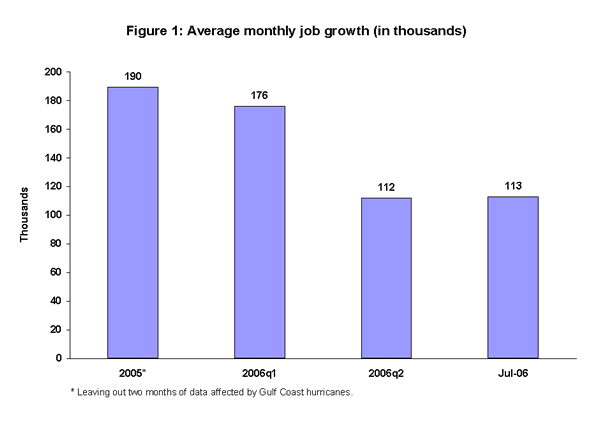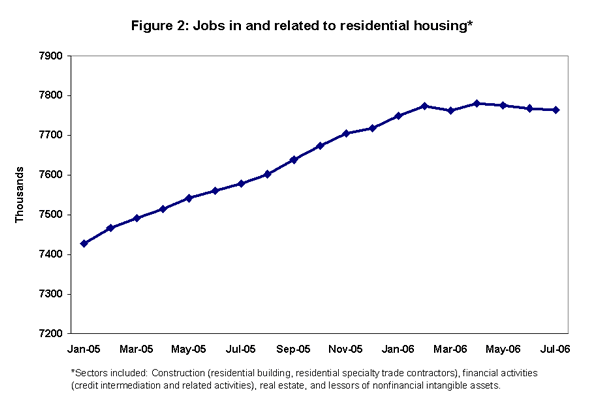August 4, 2006
Slowing housing market contributes to downshift in job growth
by Jared Bernstein with research assistance from Yulia Fungard
The nation’s payrolls expanded by 113,000 in July, according to today’s report from the Bureau of Labor Statistics, providing yet another month of evidence that the pace of U.S. job creation has significantly downshifted. In 2005, excluding the two months depressed by hurricanes, monthly employment grew by 190,000 jobs on average. In the first quarter of this year, that rate slowed to 176,000, and in the second quarter it dropped to 112,000, just about the same number added in July (see Figure 1).

The unemployment rate also grew by two-tenths, to 4.8%, as about 250,000 job seekers joined the jobless rolls. The growth in joblessness was concentrated among African Americans, whose rate went up from 9.0% to 9.5%, their highest rate since November of last year.
Today’s report confirms that the various headwinds that have reduced overall economic growth are also being felt in the job market. The cooling housing sector can be seen in weak residential construction job growth, which has been flat over the first half of the year. The slowing of consumption growth can be seen in retail employment, which was flat in July and down 88,000 in the past year. U.S. manufacturers continue to face steep competition from abroad, as factory employment fell 15,000 last month, driven in part by an 8,000 monthly contraction in autos and car parts.
Labor market analysts generally agree that job growth in the neighborhood of 150,000 per month is needed to absorb those entering the labor force and thus prevent the unemployment rate from rising. Although this relationship is not always clear on a monthly basis, last month the Household Survey showed an increase of over 200,000 the labor force. In tandem with weak job creation, this increase in labor force entrants is a recipe for higher unemployment.
Another indicator of July’s weakening job market was a sharp up-tick in the amount of time it is taking the unemployed to find work. The average number of weeks spent job seeking grew by over a week, from 16.2 to 17.3, the largest monthly jump since last August. The share of the unemployed who have been without work for at least half-a-year, which fell sharply in June, jumped back up in July to 18.6%, a historically high share given an unemployment rate below 5.0%.
Job growth was subdued across the economy, as 53.2% of private-sector industries added workers, the lowest share since last September. As noted, diminished activity in residential home building has been evident in recent months. Residential construction has been flat since April, and employment among residential contracting establishments is down 25,000 this year, including 9,000 last month.
This dynamic affects not only construction jobs, but it also dampens job growth in ancillary sectors. Real estate employment, for example, has been flat since April, and job growth among credit intermediaries, such as those who arrange mortgages and refinancing, is also slower.
Putting a number of these industries together creates a simple index of jobs related to the housing market. The flattening of job growth in these industries is illustrated in Figure 2. These categories added 151,000 jobs in January through July of last year, compared to only 13,000 jobs this year.

Hourly wage growth was up 0.4% for the second month in a row, and wages are up 3.8% on an annual basis. This is a notable acceleration from the 2.9% wage growth one year ago, though still below the most recent inflationary readings of 4.3% (June 2005-June 2006). The acceleration in wage growth is partly related to the tightening of the job market over the past year, but also a function of job composition, as employment has grown more quickly in higher-end sectors, like professional services, than in lower-end ones, such as retail.
Manufacturing wages, however, are bucking this trend, further revealing the deep weakness in this sector. Blue-collar factory workers saw a 1.5% gain over the past year, tied with May of this year for the lowest annual gain in nominal wages (before adjusting for inflation) in almost 20 years.
In sum, the slowdown in employment growth appears to be consistent with slowing in the wider economy. This likely means longer job searches for new and returning workers entering the job market, and this could put upward pressure on the unemployment rate in coming months. Though wages are still rising at a decent clip, this dynamic will ultimately put the brakes on wage growth. While that may encourage central bankers worried about (phantom) wage pressures on prices, it’s a tough deal for most workers, whose paychecks still lag inflation.
To view archived editions of JOBS PICTURE, click here.
The Economic Policy Institute JOBS PICTURE is published each month upon release of the Bureau of Labor Statistics’ employment report.
EPI offers same-day analysis of income, price, employment, and other economic data released by U.S. government agencies. For more information, contact EPI at 202-775-8810.